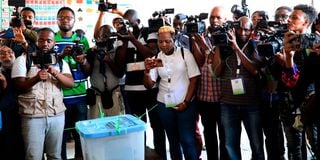Premium
Media critical in accelerating SDGs agenda

Journalism at work during the recent General Election. As an agenda setter, the media has the ability to monitor progress, highlight gaps and suggest solutions to those gaps.
As countries accelerate towards the attainment of the 17 Sustainable Development Goals (SDGSs), the media’s role as an agenda setter, a beneficiary and a key partner will come under focus in this decade of action.
As an agenda setter, the media has the ability to monitor progress, highlight gaps and suggest solutions to those gaps.
Besides, the media is also a beneficiary of a thriving SDGs agenda; under Agenda 16, the media plays a key role in promoting peace and justice as a human rights defender.
Press freedom and the right to information have a direct relevance to achieving goal 16 specifically target 10, as it envisages the protection of the right to access information and journalist safety. Freedom of information is closely linked to a culture of openness and inclusivity, which is a critical component of sustainable development.
The media, just like other sectors, is smarting from the Covid-19 pandemic. Yet other stakeholders in the SDGs spectrum will be looking up to the Fourth Estate to set the agenda, educate, inform and generally lead the conversation on the 17 goals.
During the 9th session of the UN high-level political forum on SDGS last year, Kenya committed to engaging an integrated approach to development interventions in realisation and considering the inter-linkages and integrated nature of SDGs. The acceleration strategy, which was adopted in June 2022, provides a roadmap to accelerate progress at both the national and county levels and will focus on those SDGs currently seen as unlikely to be achieved by 2030.
Missing links
Among the key components of acceleration is the awareness creation of SDGs. However, the strategy identifies the lack of a communication strategy and inadequate funding as one of the missing links. To strengthen the institutional framework for the implementation of SDGs, the media is now one of the institutions that were brought on board under the Interagency Technical Working Groups to strengthen coordination on implementation. An awards scheme to recognise top performers in the implementation of SDGs including media is in place.
Unlike the Millennium Development Goals (MDGs), which had eight goals, 18 targets and 48 indicators, the SDGs framework constitutes 17 goals, 169 targets and 231 indicators. This calls for wider engagements among all actors to ensure maximum utilisation of capacities and potential.
To facilitate this year’s awards (media category) the Media Council of Kenya and the National Treasury put out a call for entries for stories on SDGs published by media houses and freelance journalists.
It was, however, noted that many entries, especially those submitted by freelance journalists, were opinion pieces published in national newspapers. Such stories tended to feature personal opinions on suggestions of what ought to be done as opposed to entering stories with credible, authoritative and expert sources prescribing workable solutions.
The situation indicates there is an opportunity to build the capacity of journalists to tell the SDGs story.
Mr Omwoyo is the CEO of the Media Council of Kenya. [email protected]





